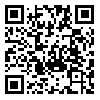2- Mashhad University of Medical Sciences
3- Mashhad University of Medical Sciences ,
Background and objective:
Given the growth of artificial intelligence-related technologies in smart cars, the existence of a tool to measure the interaction between drivers and smart cars seems essential.The existence of an instrument to measure the interaction between drivers and smart vehicles appears necessary. This study was conducted to determine the validity, reliability, and cultural adaptation of the Persian version of the Human-Machine Interaction and Interdependence Questionnaire for measuring the degree of interaction between drivers and vehicles in Iran.
Materials and Methods:
After obtaining permission, conceptual translation and examination of face and content validity, repeatability, and internal consistency were evaluated by 30 experts. Subsequently, using confirmatory and exploratory factor analyses on data collected from 312 Iranian drivers, the construct validity was examined.
Results:
the final structure of the questionnaire was extracted as consisting of 28 items across 7 primary dimensions with acceptable validity and reliability (α = 0.73 and ICC = 0.87). These dimensions were: power, conflict, mutual interdependence during decision-making, mutual interdependence in the decision outcome, future mutual interdependence, system-to-human information trust, and human-to-system information trust. The mean impact score, content validity ratio (CVR), and content validity index (CVI) were 3.77, 0.88, and 0.95 respectively.
Conclusion:
The Persian version of the Human-Machine Interaction and Interdependence Questionnaire demonstrated acceptable validity and reliability, and its multidimensional structure effectively reflects the dimensions of the mutual interdependence theory. It indicates the developed tool can serve as a valid instrument for assessing the interaction and cooperation between drivers and smart vehicles in future studies.
| Rights and permissions | |
 |
This work is licensed under a Creative Commons Attribution-NonCommercial 4.0 International License. |





